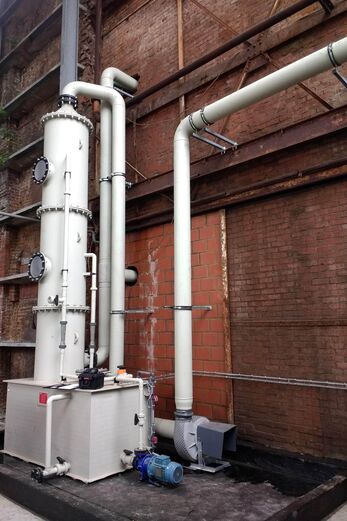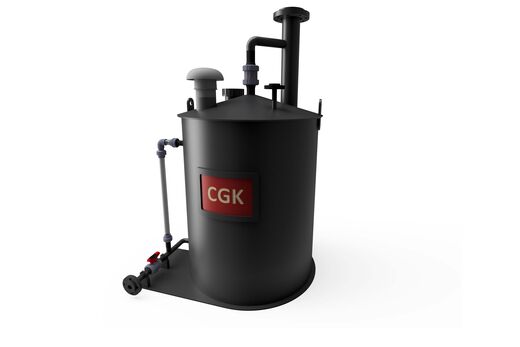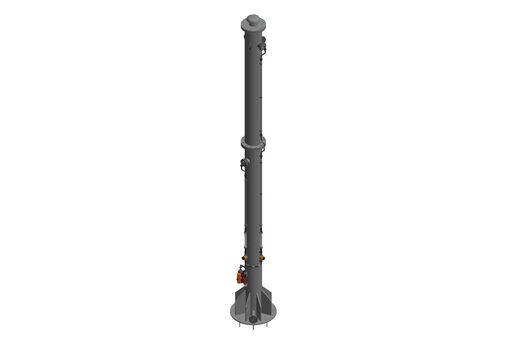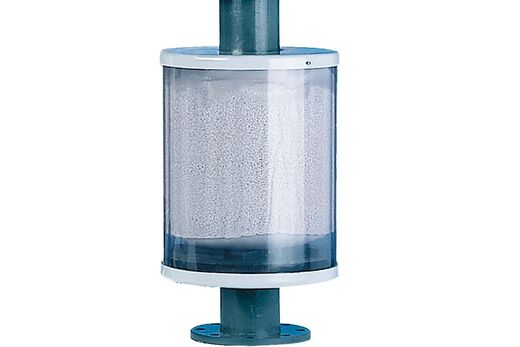Gas scrubbers: operation & legislation
A scrubber is a cleaning system for harmful gases. Products such as hydrochloric acid (HCl), acetic acid and ammonia (NH3) vaporize strongly at ambient temperature and are harmful to humans and the environment. A scrubber neutralizes these vapors after they come out of the tank vent.

When do I need a scrubber?
- The harmful effect of the medium on humans or the environment determines whether or not a scrubber is necessary.
- The volatility (vapor pressure) of the medium at the conditions used (temperature, humidity, etc.) is also a determining factor. The use of a scrubber is required by law (5.17.4.1.9 VLAREM II) at a vapor pressure of 13.3 kPa or more and at a temperature of 35°C or more. Products with a high vapor pressure evaporate faster and therefore require a scrubber.
- The relative density at 20°C of the saturated vapor or air mixture is a third important factor. If the density is between 0.9 and 1.1, then the vapors can easily mix (dissolve) with air and a scrubber is recommended.
Operation of gas scrubbers
The technique of gas scrubbing can be applied for many emissions (gaseous). The scrubber brings a gas stream in intensive contact with a certain substance: water, activated carbon, bases, biofilters ... Consequently, this substance can absorb certain components (vapors) from the gas. However, depending on its flow rate, the substance becomes saturated, requiring replacement or regeneration.
Gas scrubbing is also called absorption and is thus basically the transition of components from the gas phase to the liquid phase.
There are different types of gas scrubbers. When choosing the right scrubber, you need to consider a number of crucial factors so that the air can be completely cleared of harmful vapors. Based on an in-depth analysis, we will install the most suitable gas scrubber system for you. A passive scrubber, an active scrubber (with circulation) or a filter.
Passive scrubber
A passive scrubber can be used under certain conditions at low tank flow rates for e.g. hydrochloric acid (HCL) or acetic acid.
The passive scrubber consists of a tank usually filled with water . Chemically laden air is passed through the water to neutralize the air. The neutral air then exits the scrubber through the connection in the roof.
A major advantage of a passive scrubber is its simplicity: only on a regular basis does the liquid need to be changed. Thus, no pump or control is needed. The liquid can freeze, but this can be easily avoided by discharging it in winter, insulation and tracing or adding glycol to the water.
The contaminated water should be processed by a wastewater treatment plant or can be used in some process. Water consumption depends mainly on the solubility of the medium to be washed, the odor threshold and the flow rates to be processed.
Active scrubber
Active gas scrubbers excel especially at higher flow rates or very strong-smelling products such as ammonia 24%. Active scrubbers can handle any substance (HCl, acetic acid, NH3, HNO3, HF or SO2). Ditto for the cleaning solution, from water to bases and acids.
In an active scrubber, air enters the column at the bottom, while nozzles atomize cleaning fluid at the top. Air and liquid flow against each other, washing the dirty air. The supply of water for the cleaning liquid occurs at two 2 levels: approximately in the middle of the scrubber and quasi at the top. Atomization of the cleaning fluid is done on top of the gasket each time.
Active scrubbers also remain completely atmospheric, with less chance of overpressure due to frozen liquid. The liquids go through water treatment after the process or are still used in another process. The consumption of water and cleaning product is higher than with a passive scrubber, however.
Active gas scrubber with circulation
The active scrubber with circulation works just like our standard active scrubber. The big difference is that the rinse water is reused for a certain period of time. Therefore, the scrubber includes a circulation pump, pH measurement, etc.
This type requires a thorough study of your situation.
Vapor filter
As a simple alternative, a filter is sufficient for smaller tanks. We place the filters on the vents of the tanks.
Our filters are a plastic or stainless steel housing filled with binders such as calcium hydrate or activated carbon that neutralize harmful vapors. Here there are also options for air drying or sterilization.
Gas scrubber(s) needed in your business?
Get more information or request a free quote.
Tips & regulations
Heb ik een gaswasser nodig?
De noodzaak tot een gaswasser hangt af van de productvluchtigheid, de omgevingstemperatuur, de luchtvochtigheid ... Maar ook de dampspanning speelt een rol: hoe hoger de spanning, hoe sneller het product verdampt. Om de lucht 100% te zuiveren houdt het wasserontwerp rekening met allerlei factoren:
- Zit de wasser op de tankontluchting? Dan voorzie je best een onder- of overdrukbeveiliging op de tank.
- Een dampspanning van 13,3 kPA bij 35 °C? Dan is een gaswasser verplicht, zie ook 5.17.4.1.9 in Vlarem II.
- Tot slot is er de relatieve dichtheid van het verzadigd damp- of luchtmengsel bij 20 °C. Ligt ze tussen 0,9 en 1,1? Dan mengen de dampen zich makkelijk met lucht, ze lossen dus op.


